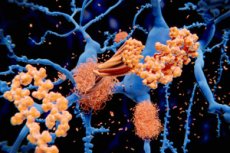A target has been found to neutralize toxic proteins in Parkinson's disease
Sist anmeldt: 14.06.2024

Alt iLive-innhold blir gjennomgått med medisin eller faktisk kontrollert for å sikre så mye faktuell nøyaktighet som mulig.
Vi har strenge retningslinjer for innkjøp og kun kobling til anerkjente medieområder, akademiske forskningsinstitusjoner og, når det er mulig, medisinsk peer-evaluerte studier. Merk at tallene i parenteser ([1], [2], etc.) er klikkbare koblinger til disse studiene.
Hvis du føler at noe av innholdet vårt er unøyaktig, utdatert eller ellers tvilsomt, velg det og trykk Ctrl + Enter.

Researchers from UAB (Autonomous University of Barcelona) have identified a site in early aggregates of the alpha-synuclein protein that can be targeted to prevent it from becoming toxic amyloid fibrils that accumulate in the brains of people suffering from Parkinson's disease.
The discovery was recently published in the Journal of the American Chemical Society in a study that deepens the understanding of the structural properties of these initial aggregates, or oligomers, and opens the door to the development of new therapeutic strategies to inactivate them.
The study was conducted by scientists Salvador Ventura, Jaime Santos, Jordi Pujols and Irantzu Palhares from the Institute of Biotechnology and Biomedicine (IBB) and the Department of Biochemistry and Molecular Biology.
Alpha-synuclein aggregation is a characteristic feature of Parkinson's disease and other synucleinopathies. This is a dynamic process in which the protein self-assembles to form oligomers that eventually develop into toxic amyloid fibrils that accumulate in the patient's brain.
Alpha-synuclein oligomers play a key role in the development and progression of disease and are therefore promising therapeutic and diagnostic targets, especially in the early stages of the disease. However, their transient and highly dynamic nature limits the study of their structure and makes it difficult to develop therapies aimed at blocking them.
In a previous study, scientists found that a small molecule, the bacterial peptide PSMα3, inhibits alpha-synuclein aggregation by binding to oligomers, blocking fibril transition, and inhibiting neurotoxicity. In this study, they determined where, how and when this binding occurs in oligomers, identifying a key region for the structural conversion process associated with the pathogenesis of Parkinson's disease.
"We have identified a sequence structure that is required to convert oligomers into fibrils, thereby opening up a new field for the development of molecules targeting oligomers. Using this area, we can develop new molecules that mimic the properties of PSMα3 with much greater affinity and potency "explains Ventura, director of the Protein Folding and Conformational Diseases Research Group at IBB and coordinator of the study.
Combining structural, biophysical and biochemical analyses, the researchers found that PSMα3 acts by binding to one end of alpha-synuclein (N-terminus), which regulates the process of converting oligomers into fibrils. When bound, the peptide covers two small adjacent regions of the protein, P1 and P2, which have been shown to be critical for this pathological transition.
"This region is an ideal therapeutic target because it is recognized by peptides only in oligomers; this allows us to target aggregates without affecting the functional monomeric form of alpha-synuclein, which is essential for normal brain function," says Ventura.
p>The study also has implications for advancing our understanding of the molecular mechanisms of the inherited form of Parkinson's disease. This form, which usually affects people at a younger age, is often associated with mutations located in the P2 region of alpha-synuclein, such as the G51D mutation, which causes one of the most aggressive forms of the disease.
Researchers have shown that the G51D mutation in the identified critical region causes conformational fluctuations that slow down the transformation of oligomers into fibrils. This slowdown results in the accumulation of toxic, long-lived oligomers, which are ineffectively processed by molecular chaperones attempting to disaggregate them.
"Our discovery could lead to the development of specific peptides that can target these mutated forms of alpha-synuclein, and therefore a personalized approach to therapy for those who suffer from an inherited form of Parkinson's disease. We are already working on developing these molecules " says Ventura.
